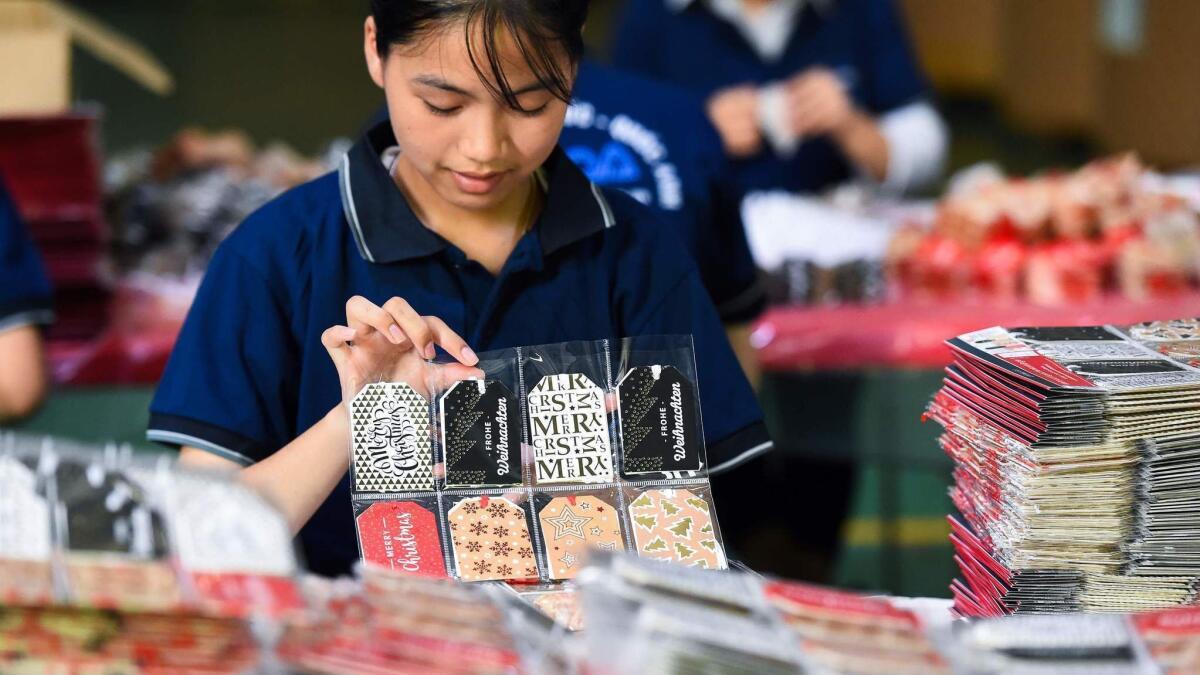Vietnam strains to reap the rewards of the U.S.-China trade war

- Share via
Reporting from Ho Chi Minh City, Vietnam — The requests that textile factory manager Huynh Thi Ai Diem receives are almost always the same: A foreign company is desperately trying to relocate production from China to Vietnam. Tariffs imposed by the U.S. have eaten away their profit margin. Can she help?
Huynh would like nothing more but is swift to provide a reality check. She only has enough workers, raw materials and factory space to produce one-fifth the volume of bath towels and apparel churned out by her chief competitors in China. Her prices are competitive, she says, but contrary to popular belief, they aren’t cheaper than those of her Chinese rivals.
“Our prices are reasonable and we can deliver good quality, but we can only take small orders,” said Huynh, a manager at Phong Phu, a 54-year-old manufacturer.
Few countries have benefited more than Vietnam from the year-old trade war between the United States and China. Companies, already under pressure from rising production costs in China, have been scrambling to identify factories to work with in the Southeast Asian country to avoid heavy tariffs.
In the first five months of 2019, Vietnamese exports to the U.S. have surged 36% compared with the same period last year. With $25 billion in shipped goods through May, Vietnam has become the eighth biggest source of American imports, up from 12th place a year ago.
But as Huynh explained, the “Made in Vietnam” label comes with a disclaimer.
The country of 97 million has one of the fastest growing economies in the world — punctuated by towering new real estate here in Vietnam’s economic center — but it’s not nearly big or developed enough to absorb the sudden exodus from China.
As some Vietnamese factory managers turn down orders because they don’t have the capacity, competition for increasingly expensive labor is forcing low-cost clothing companies to rethink their expansion plans. In addition, ports are struggling to deal with container ship traffic that’s almost doubled in the past year, according to data from MarineTraffic.
The strain on resources is helping temper expectations in a country that experts say is being unfairly compared to China, the behemoth to the north which dictated the rules of global trade the last two decades. For one thing, Vietnamese producers, unlike those in China, have to import much of their raw materials such as steel, fabric and chemicals.
“If it can be made, it’s probably being made in China. That’s not true of Vietnam,” said Jim Kennemer, founder and managing director of Cosmo Sourcing, a U.S. company with business across Asia. “Vietnam is taking over cheap and easy production, but it hasn’t done the same with more complex manufacturing yet.”
Still, Vietnam has made massive strides this decade diversifying beyond shoes and apparel to higher value products by attracting companies such as Samsung, Intel and Canon.
Samsung alone employs over 150,000 workers in Vietnam producing smartphones that accounted for nearly a quarter of Vietnam’s exports last year. The world’s biggest smartphone manufacturer started shifting production to Vietnam from China in 2011 to chase lower labor costs. The South Korean giant could serve as a model for its biggest rival Apple, which is looking to move some production out of China.
A key to attracting more multinational firms to Vietnam is infrastructure improvements, experts say. In addition to crowded ports, roads remain spotty across the country. And a first-of-its-kind metro rail project in Ho Chi Minh City has been plagued by major delays and cost overruns.
Vietnam’s Communist leaders hope some of those problems can be alleviated by foreign direct investment, which is on pace to grow in 2019 for the eighth consecutive year. Like China, the ruling party introduced major market reforms, which have attracted billions of dollars from abroad. Vietnam is under growing pressure to modernize its logistics network, which the World Bank ranks 39th in the world — 13 and 14 places behind China and South Korea, respectively.
“Businesses from China, Europe and the U.S. want to see Vietnam further position itself as a viable alternative for lower-end production,” Pham Hong Hai, chief executive of HSBC Vietnam, said in a statement. “However, to convert its much-touted supply chain potential, the country needs to build more visibility and credibility among international firms, particularly in their ability to handle and deliver production orders.”
Tariffs pressure Chinese factories to upgrade or move, not to the U.S. but to a ‘second China’ »
Logistics networks that do exist are being tested like never before.
Much of the increase in exports here is believed to be the result of companies in China rerouting finished goods through Vietnam to parry American tariffs — a practice that has drawn the ire of President Trump, who last month said Vietnam was “the single worst abuser” on trade with the U.S.
Hanoi has since pledged to purchase more U.S. goods to reduce a trade deficit with Vietnam that hit a record $39.4 billion last year (Hanoi and Washington have grown closer over a mutual distrust for Beijing, underscored by Vietnam’s resistance to Huawei in future 5G networks.)
The clamor for factories in Vietnam could subside if Washington and Beijing strike a long-term trade deal. But optimism remains high that the country that launched market reforms in 1986 is on a steady economic ascent.
More than two-thirds of Vietnam’s population is under 35 years old, meaning favorable demographics to fuel its rise. Free trade agreements, including one struck with the European Union at the end of June, could further bolster the economy.
“There’s so much opportunity here,” said Tia Nguyen, who is among a growing number of overseas Vietnamese, known here as Viet Kieu, who have returned to their native country.
Nguyen, 28, left Australia in February after living in Melbourne for five years. Her boyfriend, an automotive engineer, will join her this month and was offered a lucrative job at VinFast, Vietnam’s first domestic carmaker. Nguyen now works at Sourcify, a San Diego-based start-up that links clients with factories and has offices in Vietnam, China, India and Cambodia.
Its founder, Nathan Resnick, said about a quarter of his customers are moving production from China to Vietnam.
“My inbox was flooded,” Resnick said of the days following U.S. tariff announcements against China in May and last July.
Inquires to Sourcify have doubled in recent months, he said, because foreign companies can’t easily find factories in Vietnam like they can in China by searching Alibaba.
One of those factories is Tellbe Vietnam, a metal fabrication plant located in an industrial suburb of Ho Chi Minh City on land that used to be a snake-infested lemon grove. For more than two decades, the factory has seen growth in its business making stainless steel racks, metal dolly carts and display signs, including ones for Volvo (the company has Swedish investment).
But general director Lam Trong Nhan laments the factory could become more profitable with more government support such as tax relief and a reduced reliance on Chinese steel imports.
“My costs go up every year,” said Lam, who is currently able to match the prices of competitors in China. “But I can’t increase my prices, or I risk losing customers.”
His wife, Che Lam, Tellbe’s art director and product development manager, said the factory has room to add more orders and hopes to win new U.S. customers as a result of the trade war — one of the reasons why it responded to an inquiry from Sourcify.
“The world is turning its eyes to Vietnam,” she said. “It’s still the Wild Wild West here, but you get the sense anything is possible. We’re trying to ride the wave.”
[email protected] | Follow me @dhpierson
More to Read
Sign up for Essential California
The most important California stories and recommendations in your inbox every morning.
You may occasionally receive promotional content from the Los Angeles Times.











